Myasthenia gravis nursing care plan, an essential guide for nurses, provides a comprehensive approach to the management of this complex neuromuscular disorder. It encompasses a thorough understanding of the disease pathophysiology, clinical manifestations, and evidence-based nursing interventions tailored to the specific needs of MG patients.
This plan empowers nurses to effectively assess, monitor, and intervene in the care of MG patients, ensuring optimal outcomes and enhancing their quality of life.
Overview of Myasthenia Gravis
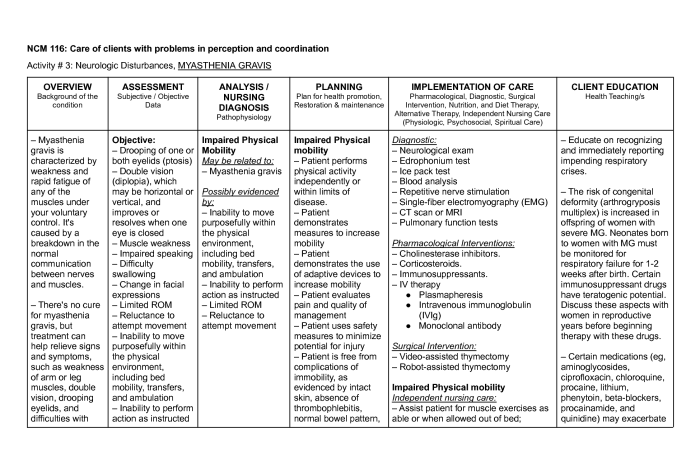
Myasthenia Gravis (MG) is a chronic autoimmune disorder that affects the neuromuscular junction, leading to muscle weakness and fatigue.
MG is caused by the production of antibodies that block or destroy acetylcholine receptors at the neuromuscular junction. Acetylcholine is a neurotransmitter that allows nerve impulses to be transmitted to muscles, enabling muscle contraction. When these receptors are blocked or destroyed, muscle weakness occurs.
Signs and Symptoms
The most common signs and symptoms of MG include:
- Muscle weakness, particularly in the face, eyes, throat, and limbs
- Drooping eyelids (ptosis)
- Double vision (diplopia)
- Difficulty swallowing (dysphagia)
- Slurred speech (dysarthria)
- Fatigue
Types of MG
There are several types of MG, classified based on the distribution of muscle weakness:
- Ocular MG:Affects only the muscles of the eyes.
- Generalized MG:Affects muscles throughout the body.
- Bulbar MG:Affects muscles of the head and neck, including the eyes, mouth, and throat.
- Respiratory MG:Affects muscles involved in breathing.
Nursing Assessment for MG
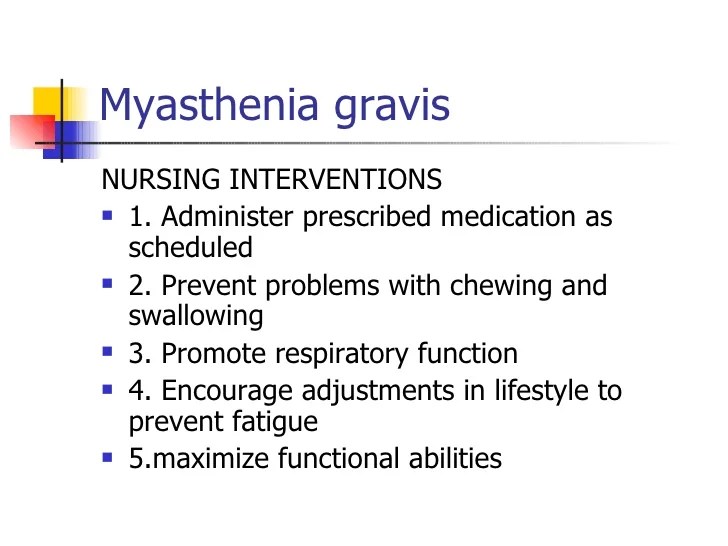
A comprehensive nursing assessment is crucial for MG patients to identify their specific needs and develop an appropriate care plan. This assessment should focus on evaluating muscle strength, respiratory function, and neurological status, as well as monitoring vital signs and oxygen saturation levels.
Muscle Strength Assessment
- Assess muscle strength using the Medical Research Council (MRC) scale or other standardized methods.
- Evaluate strength in all major muscle groups, including the limbs, trunk, neck, and face.
- Note any asymmetry or weakness in specific muscle groups.
Respiratory Function Assessment
- Monitor respiratory rate, depth, and effort.
- Auscultate breath sounds for any wheezing, rales, or decreased air entry.
- Assess for signs of respiratory distress, such as dyspnea, tachypnea, or cyanosis.
Neurological Status Assessment
- Evaluate pupillary reflexes, eye movements, and facial expressions.
- Assess speech, swallowing, and coordination.
- Check for sensory deficits, such as paresthesia or numbness.
Vital Signs and Oxygen Saturation Monitoring
- Monitor vital signs, including heart rate, blood pressure, and temperature, regularly.
- Measure oxygen saturation levels using pulse oximetry.
- Note any abnormalities or fluctuations in vital signs or oxygen saturation levels.
Nursing Interventions for MG
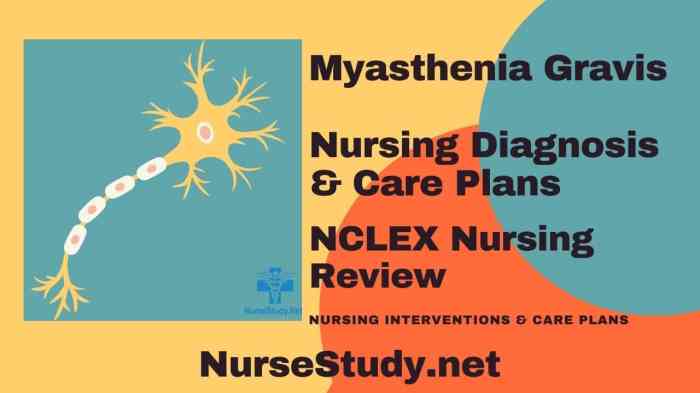
Nursing interventions for myasthenia gravis (MG) focus on managing muscle weakness, preventing complications, and providing supportive care. Interventions are tailored to the individual patient’s needs and the severity of their symptoms.
Managing Muscle Weakness
- Activity Modification:Encourage rest periods and plan activities to avoid fatigue. Prioritize essential tasks and delegate when possible.
- Assistive Devices:Provide canes, walkers, or wheelchairs to assist with mobility. Consider adaptive equipment for daily activities (e.g., button hook, long-handled utensils).
- Positioning:Maintain proper body alignment and support weak muscles with pillows or braces. Avoid prolonged sitting or standing.
- Muscle Strengthening Exercises:Supervised exercises can improve muscle strength and endurance. Start with gentle exercises and gradually increase intensity.
Preventing Complications
- Respiratory Monitoring:Assess respiratory status regularly. Monitor for signs of respiratory distress (e.g., dyspnea, tachypnea, decreased breath sounds).
- Nutritional Support:Ensure adequate nutrition to prevent weight loss and muscle wasting. Consider enteral or parenteral nutrition if oral intake is compromised.
- Immunosuppressant Therapy:Administer immunosuppressants (e.g., prednisone, azathioprine) as prescribed to reduce inflammation and suppress the immune response.
Managing Cholinergic Crisis
- Early Recognition:Monitor for signs of cholinergic crisis (e.g., severe muscle weakness, respiratory distress, salivation, diaphoresis).
- Atropine Administration:Administer atropine as prescribed to block the effects of excessive acetylcholine.
- Respiratory Support:Provide mechanical ventilation if respiratory distress is severe.
Role of Medications
- Pyridostigmine:An acetylcholinesterase inhibitor that improves neuromuscular transmission. It is the first-line medication for MG.
- Immunosuppressants:Prednisone and azathioprine are commonly used to suppress the immune system and reduce inflammation.
Patient Education and Support: Myasthenia Gravis Nursing Care Plan
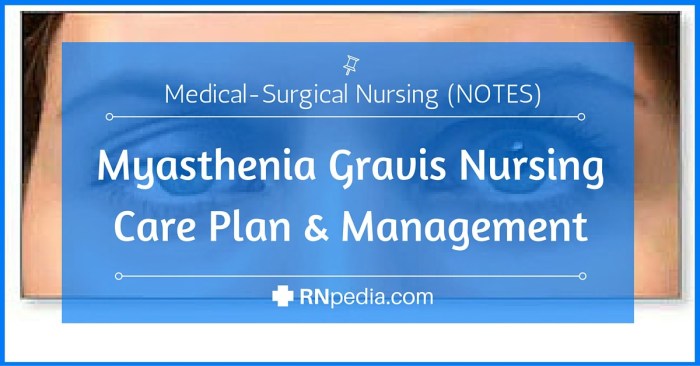
Educating patients about MG and empowering them with self-management strategies are crucial for improving their quality of life. Healthcare professionals should provide comprehensive education and support to patients with MG.
Essential Patient Education Topics
- Understanding MG, its causes, symptoms, and potential complications
- Medication management, including dosage, administration, and potential side effects
- Lifestyle modifications to manage symptoms, such as rest, stress management, and avoiding triggers
- Coping strategies for dealing with the emotional and physical challenges of MG
- Importance of regular follow-up appointments and monitoring for disease progression
Importance of Patient Support Groups and Resources
Connecting patients with MG to support groups and resources can provide invaluable emotional and practical support. Support groups offer a platform for patients to share experiences, gain insights, and access information from others living with the condition.
Monitoring and Evaluation
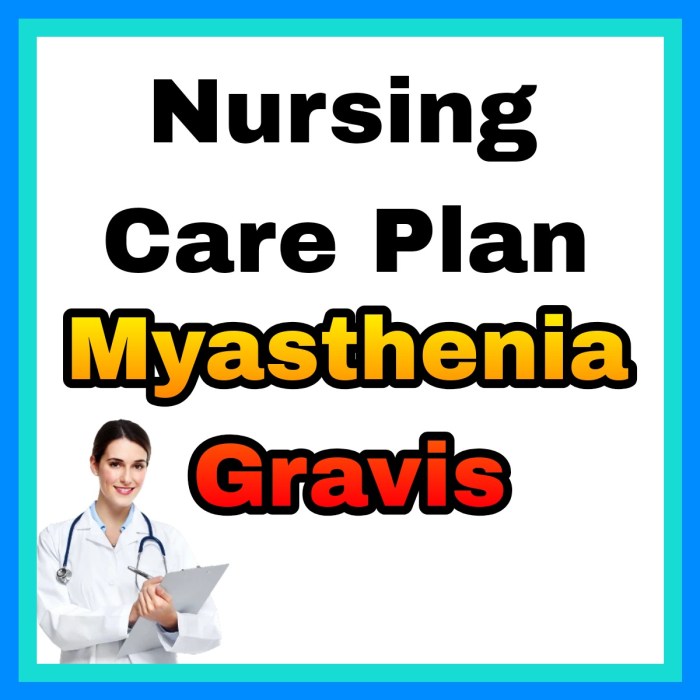
Ongoing monitoring and evaluation are crucial for MG patients to assess disease progression, treatment effectiveness, and overall health status.
The following parameters should be monitored regularly:
Muscle Strength
- Manual muscle testing (MMT) or quantitative myasthenia gravis (QMG) scoring to assess muscle strength in key muscle groups, such as the limbs, eyes, and neck.
- Repetitive nerve stimulation (RNS) or single-fiber electromyography (SFEMG) to evaluate neuromuscular transmission and detect changes in nerve-muscle function.
Respiratory Function, Myasthenia gravis nursing care plan
- Spirometry or peak flow measurements to assess lung function and respiratory capacity.
- Pulse oximetry to monitor oxygen saturation levels.
- Observation of respiratory rate and effort for signs of respiratory distress.
Medication Effectiveness
- Monitoring for clinical improvement in muscle strength and other symptoms.
- Assessing the need for dosage adjustments or changes in medication regimen.
- Monitoring for adverse effects or complications of MG medications.
Periodic Laboratory Tests and Imaging Studies
- Blood tests (e.g., anti-acetylcholine receptor antibody titers) to assess disease activity and monitor response to treatment.
- Chest X-rays or CT scans to evaluate for thymic abnormalities or other underlying conditions.
- Electrocardiography (ECG) to monitor cardiac function and detect potential complications.
Essential Questionnaire
What are the common signs and symptoms of myasthenia gravis?
Muscle weakness, drooping eyelids, difficulty swallowing, shortness of breath, and double vision.
What is the role of pyridostigmine in MG management?
Pyridostigmine is an acetylcholinesterase inhibitor that improves neuromuscular transmission by increasing the availability of acetylcholine at the neuromuscular junction.
What are the key components of patient education for MG?
Medication management, lifestyle modifications, coping strategies, and the importance of support groups.